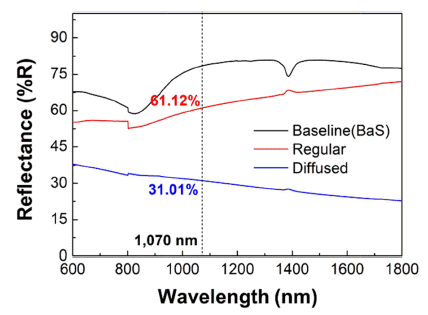Search
- Page Path
- HOME > Search
- [Korean]
- Mn-doping Effect on the Blackness and NIR Reflectance of Fe2O3 Cool Pigments
- Jin Soo Hwang, Kyeong Youl Jung
- J Korean Powder Metall Inst. 2021;28(1):38-43. Published online February 1, 2021
- DOI: https://doi.org/10.4150/KPMI.2021.28.1.38

- 594 View
- 5 Download
-
 Abstract
Abstract
 PDF
PDF A high NIR-reflective black pigment is developed by Mn doping of Fe2O3. The pigment powders are prepared by spray pyrolysis, and the effect of the Mn concentration on the blackness and optical properties is investigated. Mn doping into the crystal lattice of α-Fe2O3 is found to effectively change the powder color from red to black, lowering the NIR reflectance compared to that of pure Fe2O3. The pigment doped with 10% Mn, i.e., Fe1.8Mn0.2O3, exhibits a black color with an optical bandgap of 1.3 eV and a Chroma value of 1.14. The NIR reflectance of the prepared Fe1.8Mn0.2O3 black pigment is 2.2 times higher than that of commercially available carbon black, and this material is proven to effectively work as a cool pigment in a temperature rise experiment under near-infrared illumination.
- [Korean]
- Reflectance Characteristics of Al-Si based Alloys according to Powder Size and Composition
- Gwang Mook Choi, Hong Jun Chae
- J Korean Powder Metall Inst. 2019;26(1):22-27. Published online February 1, 2019
- DOI: https://doi.org/10.4150/KPMI.2019.26.1.22

- 556 View
- 1 Download
-
 Abstract
Abstract
 PDF
PDF In this study, the effects of powder size and composition on the reflectance of Al-Si based alloys are presented. First, the reflectance of Al-Si bulk and powder are analyzed to confirm the effect of powder size. Results show that the bulk has a higher reflectance than that of powder because the bulk has lower surface defects. In addition, the larger the particle size, the higher is the reflectance because the interparticle space decreases. Second, the effect of composition on the reflectance by the changing composition of Al-Si-Mg is confirmed. Consequently, the reflectance of the alloy decreases with the addition of Si and Mg because dendrite Si and Mg2Si are formed, and these have lower reflectance than pure Al. Finally, the reflectance of the alloy is due to the scattering of free electrons, which is closely related to electrical conductivity. Measurements of the electrical conductivity based on the composition of the Al-Si-Mg alloy confirm the same tendency as the reflectance.
TOP
 kpmi
kpmi

 First
First Prev
Prev


